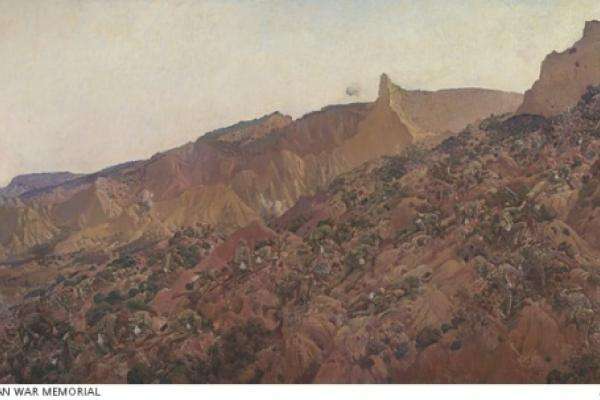The Clowes family
Canberra had not yet been officially announced as the new Australian capital when Queensland-born brothers Cyril and Norman Clowes marched into the Royal Military College (RMC) at Duntroon in 1911. Nineteen-year-old Cyril and his younger brother, 17-year-old Norman, were among the first cadets to enter the newly established RMC and begin the four-year course.
Group portrait of Lieutenant Cyril Albert Clowes (left), and his brother Lieutenant Norman Clowes (right) with an unidentified British officer, c. 1914–1916. (AWM P06234.002)
Their training was cut short in 1914 by the announcement that Britain, and therefore Australia, was at war with Germany. Cyril and Norman graduated early from RMC in August that year, and were both commissioned as lieutenants in the Australian Imperial Force.
By the time Cyril and Norman set sail from Australia two months later, the Allies and the rapidly-moving German army had reached a deadlock on the battlefields across France and Belgium. The British began to plan an attack on Germany’s ally, Turkey, in the hopes that this might relieve Russia, encircle the Central Powers, and bring the stalemate on the Western Front to an end.
As dawn broke over the Gallipoli peninsula on 25 April 1915, the Clowes brothers found themselves scrambling ashore and scaling the treacherously steep terrain. Over 2,000 Australian troops were wounded or killed on this day alone, and the men of the Australian and New Zealand Army Corps were forced to retreat to the second ridge. This was the start of a gruelling eight month campaign.
In early May, Cyril was directing nearby ships to fire upon Turkish strongpoints when he was wounded. His brother had been shot in the chest a week earlier. Both quickly recovered from their injuries but Cyril’s wound rendered him partially deaf and he battled with this condition for the rest of his life.
After the Gallipoli evacuation, the Australians went into action on the Western Front to support British efforts on the Somme. Hardened by their experiences on the peninsula, Cyril and Norman proved themselves to be brave and dedicated soldiers and both quickly rose through the ranks. But little could prepare them for the devastating fighting at Pozières in mid-1916.
From late July, constant shelling had laid waste to this small French village. More than 23,000 Australian soldiers were killed or wounded in the attempt to capture ground over just 42 days. The costs were staggering, but Cyril and Norman continued to serve as best they could.
This meant leading perilous operations under intense fire. Each earned a Military Cross for his courage. As the war dragged on, Cyril and Norman did not waver in their commitment to their roles and further accolades followed. By the time the guns fell silent on November 1918, they had each received a Distinguished Service Order as well as awards from the Serbian and French governments.
Norman transferred to the British army shortly after the end of the war and forged a distinguished career. Cyril returned to Canberra and served as an instructor at RMC Duntroon. A few years later, he married Eva Magennis at her family’s homestead near Yass. Cyril worked at defence posts across Australia until the outbreak of the Second World War in 1939. He served with distinction throughout this conflict and at Milne Bay became the first Allied commander to succeed in a land action against Japanese forces in the Pacific.


